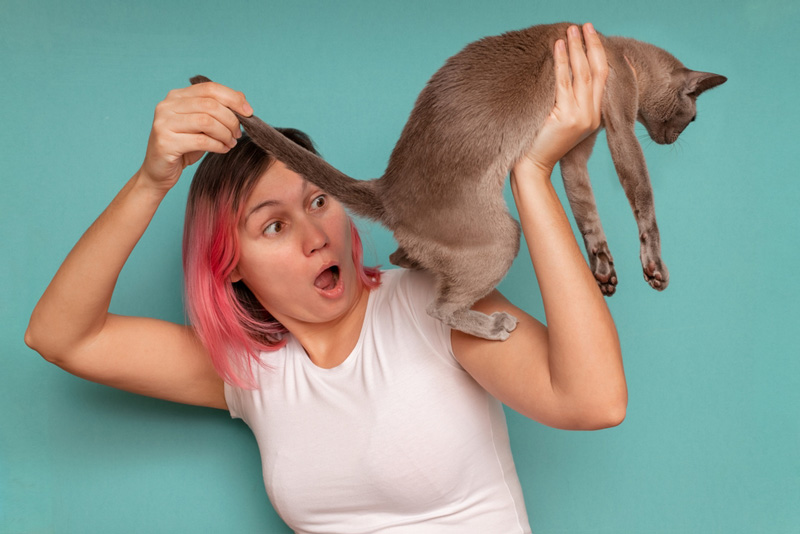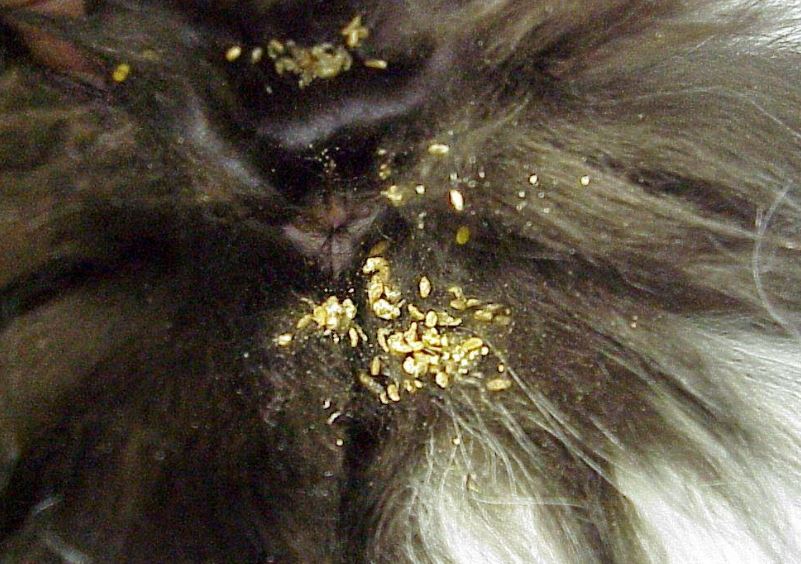Wondering about worms? Natural options here…
One of the ways to potentially help your pet manage parasite infestations is ensuring they have a robust immune system, and in particular additional probiotics.
Our supplements ULTIMATE Feline have additional probiotics.
Dr Jones’ Ultimate Feline Health Formula
Dr Jones’ Ultimate Canine Health Formula

Typically cat parents see ‘grains of rice around the rear end’… these are tapeworm segments…

Worms in Dogs and Cats
SIGNS
You see small white squiggly worms in your pet’s stool. Your cat has something that resembles grains of rice coming from the bum. Your pet may be vomiting or have diarrhea. Your pet is losing weight.
CAUSES
Worms in dogs are very common, with up to one-third of all dogs being infected with intestinal parasites: roundworms, tapeworms, coccidian, and giardia. I’ll go over the most common types of worms and how you can tell if your dog has worms. I’ll then go on to show you how to prevent dog worms and give the best ways to treat them, both with conventional medication and natural solutions.
Roundworms are most common; these worms are one to three inches long, white, and tapered or round–hence the name roundworm. The veterinary name for roundworms is Toxocara canis. These are what most puppies have when diagnosed with worms. Dogs with roundworms often have a distended belly that appears bloated. In large infestations they can cause vomiting, diarrhea, and weight loss, although most pet owners diagnose them by seeing a worm in their dog’s stool. These are easily transmitted from dog to dog via worm eggs in the stool and on the ground.
Tapeworms are the next most common intestinal parasite of dogs; they are known as Dipylidium canis. Most dogs with tapeworms have few clinical signs, although a heavy infestation can cause intestinal upset and weight loss. These are easy to diagnose by finding segments of the tapeworm in your dogs stool–the segments are flat, white, and sometimes described as flat grains of rice. Dogs acquire most tapeworms after ingesting a flea; the tapeworm lifecycle includes maturing in a flea to be able to be transmitted to other dogs. Tapeworms can also be transmitted with other animals, such as your dog ingesting a mouse.
Coccidia are worm like, microscopic intestinal parasites that commonly causes diarrhea in puppies, but can affect older dogs with compromised immune systems. Coccidia are spread from dog to dog via eggs in the stool, contaminating the water and environment. Some dogs can have a small number of coccidia in their intestinal tract, but the organism flourishes if the pup is under stress(such as overcrowded, unsanitary conditions), leading to diarrhea. Coccidia can be diagnosed with a veterinary microscopic fecal flotation, and should be suspected in any puppy with diarrhea that doesn’t respond to traditional roundworm treatment.
Giardia is a waterborne intestinal parasite that more commonly affects adult dogs, causing diarrhea; it is also known as “beaver fever.” Giardia gets into the water via contamination by wild animals (such as beavers) and infected dogs. The giardia cysts multiply in the intestinal tract, leading to the signs of diarrhea with blood or mucous in the stool. It is a very difficult parasite to diagnose in veterinary practice, so many clinicians may just treat your dog for it with a conventional anti-giardia medication.
SOLUTIONS
HYGIENE and COMMON SENSE: Good hygiene and common sense is the best way to prevent your dogs from getting dog worms in the first place. Pick up feces outside on your lawn, and prevent your dog from eating other dogs’ feces. Restrict your dog from drinking water in contaminated creeks, or water that is stagnant in small pools. Practice adequate flea control to limit the likelihood of tapeworms, and ensure that your dog has a hygienic, uncrowded environment to decrease the chances of developing coccidia.
CONVENTIONAL OPTIONS: The conventional treatment for dog worms depends upon the type of intestinal parasite your dog has. Roundworms are easy to treat with a common, safe medication called pyrantel palmoate; avoid using any of the older dewormers containing piperazine as they can be very unsafe.
Treatment with pyran (pyrantel) is two doses, ten to fourteen days apart. As most puppies have roundworms, I suggest having them all dosed with pyran at six and eight weeks; they may need additional treatments.
Tapeworms respond well to treatment with praziquantel, which may be combined with pyran (drontal); generally only one dose is required.
Coccidia respond best to the sulfa antibiotics, usually sulfadimethoxine (S-125, or Albon); the dose being 250mg per ten pounds once daily for fourteen to twenty-one days.
Giardia can be treated with two common conventional medications: metronidazole and fenbendazole. Fenbendazole is also effective against other intestinal parasites and is becoming the treatment of choice for giardia. The fenbendazole dose is 250mg per ten pounds once daily for three to seven days.
DIATOMACEOUS EARTH. This is the most effective and safest holistic de-wormer. It is important to get the DE safe for ingestion. Dose it at 1/2 teaspoon/10lbs twice daily for 21 days to treat most internal parasites. Also works well topically for fleas.
PAPAYA. This was shown to be effective in eliminating roundworms in pigs; it may work for your pet, and at the least it will do no harm.
PUMPKIN SEED. This has been used for tapeworms. If your pet is a great hunter, always getting re-infested with tapeworms, you may want to consider this. The dose is one teaspoon per ten pounds of body weight of the ground seed.
HERBAL:
BLACK WALNUT (Juglans nigra). This is a common anti-parasitic used for animals: give one capsule of the ground herb per twenty pounds of body weight.
GARLIC. This has shown some activity against giardia (causes beaver fever). It is useful in recurrent infections. 1/4 clove/10lbs daily for 14 days
HOMEOPATHIC:
CINA. For roundworms, use Cina 30C, one tab every eight hours for twenty-one days.
FILIX MAS. For tapeworms, use Filix Mas 30C, one tab every eight hours for twenty-one days.

Best Wishes,
Dr Andrew
P.S. I have used ground pumpkin seed effectively on my own animals.

Hello, my cat has an eye infection. My vet will not help me because I complained about their price and worms. What would you suggest that I buy for her?
Here are some helpful tips:
Eye Infections in Dogs and Cats
Your pet’s eyes are one of the more critical and sensitive parts of their anatomy. There are a number of different eye disorders, and many of those are amenable to at-home remedies.
Common eye disorders include conjunctivitis(red eye or pinkeye), epiphora (excessive tearing), uveitis, KCS (dry eye), glaucoma, cataracts, corneal ulceration, and PRA (progressive retinal atrophy).
Conjunctivitis is defined as inflammation of the red, conjunctival tissue around your pet’s eye. It is the most common cause of red eye in dogs and cats.
There are many at-home remedies that can be used for conjunctivitis.
Epiphora, or excessive tearing, is usually a result of the tear ducts being obstructed, and the tears cannot be drained normally. They are then visible streaming down the corner of your pet’s eyes.
Cats commonly have upper respiratory viral infections that can predispose them to recurring eye tearing.
Keratoconjunctivitis sicca (KCS), or dry eye, is caused by a lack of tear production. The signs are a dry-looking, mucoid eye, with accompanied inflammation.
SIGNS
Your pet’s eyes are red with a yellow or green discharge. The eyes continue to water. Your pets quints or rubs his or her eyes. The tissue around the eye appears swollen. With cataracts, the middle of the eye (the lens) appears cloudy (see Cataracts).
CAUSES
The causes of red eye are numerous. The most common are bacterial conjunctivitis, bacterial infection of the tissue around the eye, and allergic conjunctivitis. Other more serious causes include glaucoma (swelling in the eye) or an ulcer on the cornea (erosion on the surface of the eye).
SOLUTIONS
TO THE VETERINARIAN. Here are three signs to trigger an immediate call to your veterinarian: if your pet’s eye infection is painful, with your pet rubbing an eye; if the main part of the eye, the cornea, appears to be indented or layered; and if the entire eye suddenly becomes cloudy.
EYE TEARS. The lubricated eye tears used for people with minor eye infections can be very soothing for your pet. First wipe any discharge away from the eyes using a damp cloth and then apply two to three drops in the affected eye three times daily.
TO THE KITCHEN. Tea is more than just a drink. It has tannins in it that are anti-inflammatory and have antimicrobial properties. Brew up a strong cup of black tea and place three to four drops in the affected eye three times daily. It should be made daily to prevent contamination.
HERBAL:
EYEBRIGHT (EUPHRASIA). This herb has antioxidant and anti-inflammatory properties. To make a solution, mix five drops of eyebright in 125 ml (one-half cup) of saline solution. Using an eyedropper, place two drops in the affected eye twice daily for five to seven days.
MORE HEALING EYE DROPS. Instead of using Euphrasia, you can substitute one of these herbs: RASPBERRY, NETTLE OR
OREGON GRAPE. Mix five drops of one of these herbs in 125 ml (one-half cup) of saline solution. Using an eyedropper, place two drops in the affected eye twice daily for five to seven days.
EXCESSIVE TEARING
WIPE AWAY. Use a damp cloth to wipe off crusted discharge around the nose and eyes. If the corner of the eye is red and inflamed, also use a topical anti-inflammatory, such as aloe or aloe/calendula cream; a cloth soaked in black tea is another option.
AMINO ACID LYSINE. L-lysine has proven antiviral activity and is a mainstay in treating and curing cats with recurrent herpesvirus respiratory infections. It comes as a veterinary paste (Enisyl). The dose is 100mg per ten pounds twice daily for at least twelve weeks. (This is also found in Ultimate Canine and Ultimate Feline Health Formula.)
PROBIOTICS. Probiotics (the healthy natural bacteria) seem to modify the bacteria in the gut, but also the skin. In the cases of tear staining, they appear to decrease the bacteria that produce the pigment that shows up as a stain (i.e., less melanin). The most effective supplement is lactobacillus acidophilus; give one-fourth capsule per ten pounds of body weight twice daily. (This is also found in Ultimate Canine and Ultimate Feline Health Formula.)